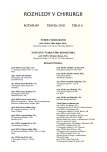Laparoscopic Hernioplasty TAPP in Treatment of Groin Hernia – 10 Years Experience
Authors:
M. Šoltés; P. Pažinka; J. Radoňak
Authors‘ workplace:
I. chirurgická klinika LF UPJŠ a FNLP, Košice, Slovenská republika, prednosta: prof. MUDr. J. Radoňak, CSc.
Published in:
Rozhl. Chir., 2010, roč. 89, č. 6, s. 384-389.
Category:
Monothematic special - Original
Overview
Aims:
To analyse individual and institutional „learning curve“ in laparoscopic transabdominal preperitoneal hernioplasty (TAPP) and to identify key moments in its introduction at surgical clinic.
Material and methods:
Prospective unicentric clinical study. Longitudinal recording of information on age and sex of operated patients, type of hernia, size of implanted mesh, operative tactics and technique, complications and recurrence rate was performed. Obtained data was statistically analysed and tested repeatably, results interpreted with respect to need of modification of peri - and postoperative management.
Results:
During the 10 year period 1058 laparoscopic hernioplasties TAPP were performed with overall recurrence rate 0.96% and zero conversion rate. Mean operating time was 60.15 ± 24.27 minutes (30–175), 46.64 ± 19.23 minutes in the last three years (last 541 patients). Thanks to prospective analysis of obtained results three important changes in the operative management were introduced: size of mesh enlarged from 7,5 x 15 cm to 10 x 15 cm, change of operating team and port sites set up and shift towards macroporous 3D-knitted light-weight polypropylene meshes.
Conclusions:
Crucial factor for successfull introduction of laparoscopic hernioplasty TAPP at surgical clinic is consistent follow-up which represents a source of valid information thus allowing to make important changes in patient management. TAPP represents demanding operation with significant individual and institutional learning curve. Operating time decreases significantly after 30 operations; with growing institutional experience recurrence rate decreases. Minimal size of implanted mesh should be 10 x 15 cm.
Key words:
groin hernia – laparoscopic hernioplasty – recurrence – operative technique – complications – learning curve
Sources
1. Schmedt, C. G., Sauerland, S., Bittner, R. Comparison of endoscopic procedures vs Lichtenstein and other open mesh techniques for inguinal hernia repair. Surg. Endosc., 2005; 19 : 188–199.
2. Rosenberg, J., Bay-Nielsen, M. Current status of laparoscopic inguinal hernia repair in Denmark. Hernia, 2008; 12 : 583–587.
3. Bittner, R., Schmedt, C. G., Schwarz, J., et al. Laparoscopic transperitoneal procedure for routine repair of groin hernia. Br. J. Surg., 2002; 89 : 1062–1066.
4. Leibl, B. J., Jager, C., Kraft, K., et al. Laparoscopic hernia repair TAPP or/and TEP? Langenbeck‘s Arch. Surg., 2005; 390 : 77–82.
5. Leibl, B. J., Schmedt, C. G., Kraft, K., et al. Scrotal hernias: a contraindication for an endoscopic procedure? Results of a single institution experience in transabdominal preperitoneal repair. Surg. Endosc., 2000; 14 : 289–292.
6. Neumayer, L., Giobbie-Hurder, A., Jonasson, O., et al. Open mesh versus laparoscopic mesh repair for inguinal hernia. N. Engl. J. Med., 2004; 350 : 1819–1827.
7. Molnár, P., Marko, Ľ., Kothaj, P. Laparoskopická transabdominálna preperitoneálna plastika v liečbe inguinálnej hernie. Miniinvazívna chirurgia a endoskopia: chirurgia súčasnosti, 2005; 9 : 16–21.
8. Fingerhut, A., et al. Inguinal hernia repair. In: Neugebauer, E. A. M., Sauerland, S., Fingerhut, A., et al.: EAES Guidelines for Endoscopic Surgery. 1. vyd. Berlín Heidelberg, Springer, 2006 : 296–309.
9. Beneš, Z., Herdegen, P., Puškárová, G., et al. Komplikace laparoskopické operace tříselné kýly diagnostikované kolonoskopicky. Rozhl. Chir., 2007; 86 : 420–422.
10. Ninger, V., Bis, D. Bolesti po laparoskopické inguinální hernioplastice technikou TAPP. Rozhl. Chir., 2006; 85 : 333–337.
Labels
Surgery Orthopaedics Trauma surgeryArticle was published in
Perspectives in Surgery

2010 Issue 6
- Metamizole vs. Tramadol in Postoperative Analgesia
- Safety and Tolerance of Metamizole in Postoperative Analgesia in Children
- Metamizole in perioperative treatment in children under 14 years – results of a questionnaire survey from practice
- Obstacle Called Vasospasm: Which Solution Is Most Effective in Microsurgery and How to Pharmacologically Assist It?
Most read in this issue
- Interbody Spacers in the Treatment of Cervical Spine Disorders
- Laparoscopic Hernioplasty TAPP in Treatment of Groin Hernia – 10 Years Experience
- Abdominal Catastrophe – Surgeon’s View
- Quality of Life after Gastrectomy
